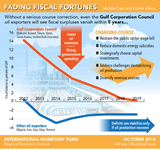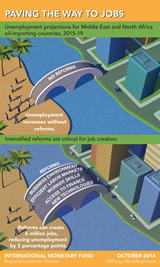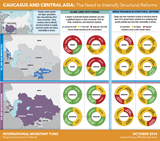Middle East and Central Asia
Regional Economic Outlook: Middle East and Central Asia
October 2014
[$token_name="PublicationDisclaimer"]

Economic developments in the Middle East, North Africa, Afghanistan, and Pakistan (MENAP) continue to reflect the diversity of conditions prevailing across the region. Most high-income oil exporters, primarily in the GCC, continue to record steady growth and solid economic and financial fundamentals, albeit with medium-term challenges that need to be addressed. In contrast, other countries—Iraq, Libya, Syria—are mired in conflicts with not just humanitarian but also economic consequences. And yet other countries, mostly oil importers, are making continued but uneven progress in advancing their economic agenda, often in tandem with political transitions and amidst difficult social conditions. In most of these countries, without extensive economic and structural reforms, economic prospects for the medium term remain insufficient to reduce high unemployment and improve living standards.
Economic activity in the Caucasus and Central Asia (CCA) region is weakening, mainly because of the near-term slowdown and rising regional tensions affecting Russia, a key trading partner and sources of remittance and investment inflows, as well as weaker domestic demand in a number of CCA countries. Near-term risks are to the downside and tied to the fortunes of large trading partners. Policies need to focus on bolstering economic stability and, where needed, short-term support to ailing economic growth. In addition, a new model for high, sustained, diversified, and inclusive growth is needed to set the direction for economic policies for the next decade.
Contents
Front Matter
MIDDLE EAST, NORTH AFRICA, AFGHANISTAN, AND PAKISTAN (MENAP)
I- MENAP Oil Exporters: Increasing Diversification, Reducing Reliance on Oil-Funded Spending
 Intensified conflicts in Iraq and Libya have led to a downward revision in the 2014 growth projections for the MENAP oil exporters by ¾ of a percentage point compared with the May 2014 Regional Economic Outlook Update.
At 2½ percent, growth in the oil exporters is expected to edge up only slightly from last year, supported by recovery in Iran and continued solid growth in the GCC countries. Growth is expected to strengthen to about 4 percent next year, assuming that security improves and oil production in non-GCC countries, particularly Libya and Iraq, recovers. In the current security environment, these projections are subject to heightened uncertainty. Declining oil revenues and rising government spending are weakening fiscal positions. Consolidation would build resilience against oil price declines and help countries share their oil wealth with future generations. Some non-GCC countries face the pressing need to draw on their savings over the near term to meet essential expenditures. Reducing the dependence of sustained economic growth on rising oil prices requires structural reforms that promote economic diversification and inclusive growth.
Intensified conflicts in Iraq and Libya have led to a downward revision in the 2014 growth projections for the MENAP oil exporters by ¾ of a percentage point compared with the May 2014 Regional Economic Outlook Update.
At 2½ percent, growth in the oil exporters is expected to edge up only slightly from last year, supported by recovery in Iran and continued solid growth in the GCC countries. Growth is expected to strengthen to about 4 percent next year, assuming that security improves and oil production in non-GCC countries, particularly Libya and Iraq, recovers. In the current security environment, these projections are subject to heightened uncertainty. Declining oil revenues and rising government spending are weakening fiscal positions. Consolidation would build resilience against oil price declines and help countries share their oil wealth with future generations. Some non-GCC countries face the pressing need to draw on their savings over the near term to meet essential expenditures. Reducing the dependence of sustained economic growth on rising oil prices requires structural reforms that promote economic diversification and inclusive growth.
- Rising 2015 Growth Depends on Improving Security
- Oil Price Risks Remain Balanced, but Geopolitical Risks Have Risen
- Falling Oil Revenues and Rising Government Spending Are Weakening Fiscal Positions
- Growth from Diversifi cation, Not Rising Oil Prices
II: MENAP Oil Importers: Slow Recovery and Modest Prospects Call for Reform
 Continued sociopolitical and security tensions, high public debt, and deep-rooted structural impediments continue to dampen the economic impetus provided by improvements in the external environment and progress in domestic political transitions—leaving growth expectations, broadly unchanged from the May 2014 Regional Economic Outlook Update, at 3 percent in 2014 and rising to 4 percent in 2015. Intensifying regional conflicts and rising geopolitical tensions augment downside risks. Progress is being made in clawing back inefficient generalized subsidies and rechanneling them to support growth through better-targeted social safety nets for the poor and growth-generating investment. Nevertheless, continued fiscal consolidation is needed to put public debt on a sustainable path and increase buffers for dealing with adverse shocks. Greater exchange rate flexibility, in some cases, would support the recovery and improve competitiveness. Beyond the near term, improved security and deep structural reforms—especially in education, the business environment, and labor market efficiency, supported by continued stabilization efforts and stepped-up international assistance—are needed to raise the region's potential growth rates, create much-needed jobs, and improve
living standards and inclusiveness.
Continued sociopolitical and security tensions, high public debt, and deep-rooted structural impediments continue to dampen the economic impetus provided by improvements in the external environment and progress in domestic political transitions—leaving growth expectations, broadly unchanged from the May 2014 Regional Economic Outlook Update, at 3 percent in 2014 and rising to 4 percent in 2015. Intensifying regional conflicts and rising geopolitical tensions augment downside risks. Progress is being made in clawing back inefficient generalized subsidies and rechanneling them to support growth through better-targeted social safety nets for the poor and growth-generating investment. Nevertheless, continued fiscal consolidation is needed to put public debt on a sustainable path and increase buffers for dealing with adverse shocks. Greater exchange rate flexibility, in some cases, would support the recovery and improve competitiveness. Beyond the near term, improved security and deep structural reforms—especially in education, the business environment, and labor market efficiency, supported by continued stabilization efforts and stepped-up international assistance—are needed to raise the region's potential growth rates, create much-needed jobs, and improve
living standards and inclusiveness.
- Fragile Confi dence Constrains Recovery
- Downside Risks Are Elevated
- Gradually Declining External and Fiscal Vulnerabilities
- Fiscal, Monetary, and Exchange Rate Policies: Going Beyond Macroeconomic Stability
- Lackluster Medium-Term Prospects
- Structural Transformation to Boost Growth
- International Support
CAUCASUS AND CENTRAL ASIA
III: Caucasus and Central Asia: Increased Risks Highlight Need for Reform
 Economic growth in the Caucasus and Central Asia (CCA) is expected to decline from 6.6 percent in 2013 to about
5.5 percent in 2014–15. The forecast is ¾ percentage point weaker than in the May 2014 Regional Economic Outlook Update, mainly because of negative spillovers from an economic slowdown and increased geopolitical risks in Russia and weaker domestic demand in a number of CCA countries. Inflation pressures are rising because of weakened exchange rates. Risks are tilted to the downside; in particular, a deeper or more protracted Russian slowdown could further weaken remittances, exports, and investment. Over the near term, countries should stand ready to tighten monetary policy if inflation pressures persist. A pause in fiscal consolidation is justifiable in some cases in response to weaker growth prospects. Medium-term policy priorities center on building credible anchors for monetary policy, introducing greater exchange rate flexibility to buffer against shocks, and growth- and equity-friendly fiscal consolidation to preserve debt sustainability and ensure intergenerational equity. Bold structural reforms that lead to better institutions, good governance, and vibrant business environments are necessary for the region to achieve an economic model that is sustainable, more inclusive, and diverse.
Economic growth in the Caucasus and Central Asia (CCA) is expected to decline from 6.6 percent in 2013 to about
5.5 percent in 2014–15. The forecast is ¾ percentage point weaker than in the May 2014 Regional Economic Outlook Update, mainly because of negative spillovers from an economic slowdown and increased geopolitical risks in Russia and weaker domestic demand in a number of CCA countries. Inflation pressures are rising because of weakened exchange rates. Risks are tilted to the downside; in particular, a deeper or more protracted Russian slowdown could further weaken remittances, exports, and investment. Over the near term, countries should stand ready to tighten monetary policy if inflation pressures persist. A pause in fiscal consolidation is justifiable in some cases in response to weaker growth prospects. Medium-term policy priorities center on building credible anchors for monetary policy, introducing greater exchange rate flexibility to buffer against shocks, and growth- and equity-friendly fiscal consolidation to preserve debt sustainability and ensure intergenerational equity. Bold structural reforms that lead to better institutions, good governance, and vibrant business environments are necessary for the region to achieve an economic model that is sustainable, more inclusive, and diverse.
- Russia’s Slowdown Is Weighing on CCA Economic Activity
- Risks Are Largely to the Downside
- Inflation Pressures Call for Effective Monetary Policy Frameworks
- External and Fiscal Positions Are Vulnerable
- Stronger Financial Systems Are Needed to Support Growth
- Time for a New Economic Model
Annexes
- Annex I. Medium-Term Economic Prospects in the MENAP and CCA Regions
- Potential Growth Is Slowing Faster Than in Other Regions
- Reasons behind Declines in Potential Growth Vary
- Policies to Raise Potential Growth - Annex II. Public Infrastructure Investment in the MENAP and CCA Regions
- Infrastructure Gaps
- Jobs and Growth Implications of Higher Public Investment
- Investment Effi ciency
- Policy Implications - Annex III. Access to Finance for Small and Medium-Sized Enterprises in the MENAP and CCA Regions
- SMEs, Inclusive Growth, and Access to Finance
- Factors Constraining SME Access to Finance
- Impact of Global Regulatory Initiatives
- Recent Reforms
- Islamic Finance
- Policy Recommendations - Annex IV. Measuring Inclusiveness in the MENAP and CCA Regions
- Mixed Performance on Poverty, Inequality, and Middle Class Size
- Low Growth and Access to Services in MENAP Oil Importers
- Lack of Employment Is a Key Inclusiveness Problem
- Acute Gender Inequality in MENAP
- Toward Better Outcomes - Annex V. Economic Cooperation and Integration in the CCA
- Rationale for Economic Cooperation and Integration in the CCA
- Status of Economic Cooperation and Integration in the CCA
- Several Factors Explain the Slow Pace of Regional Integration
- Prospects
- Policy Implications
Statistical Appendix
References
Online Media Partners
 |
 |
 |





